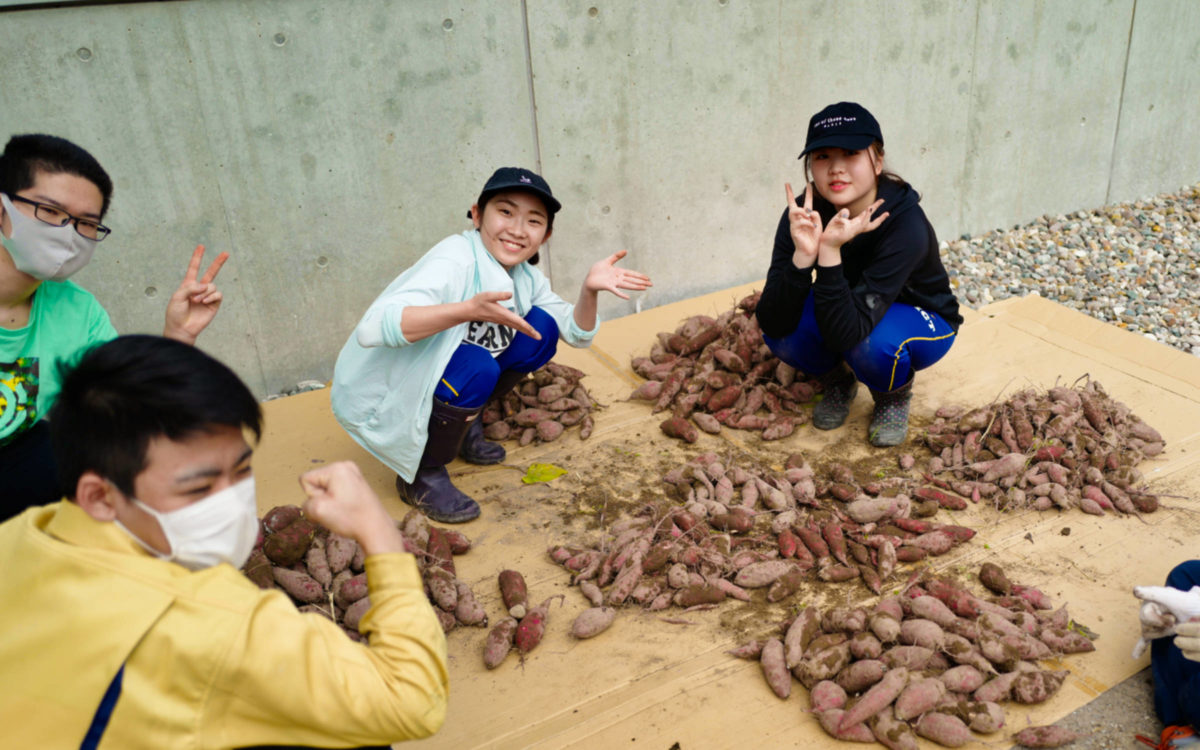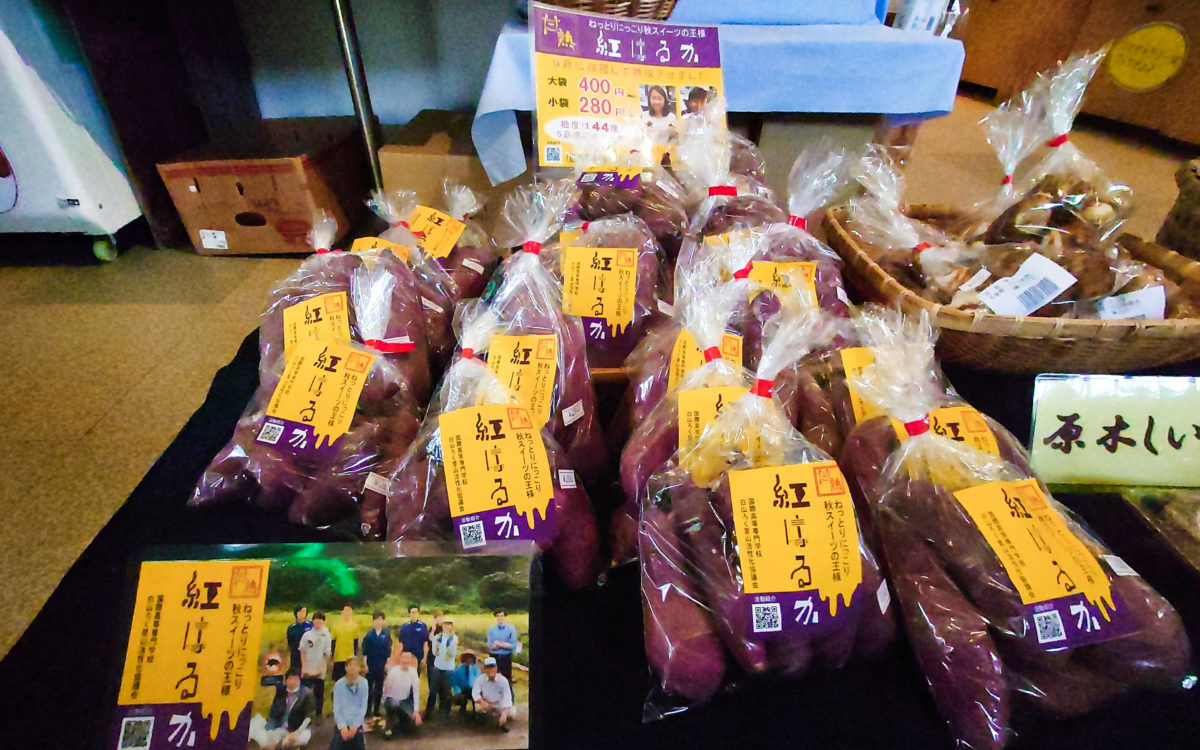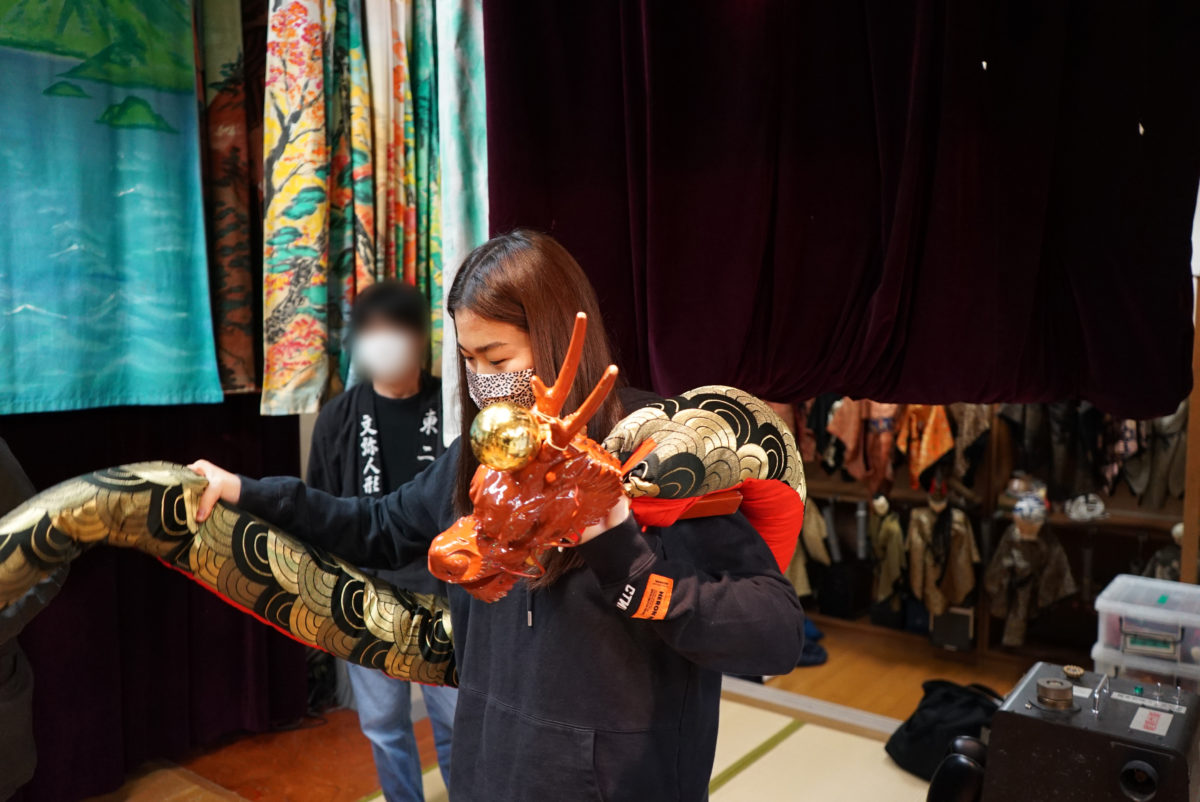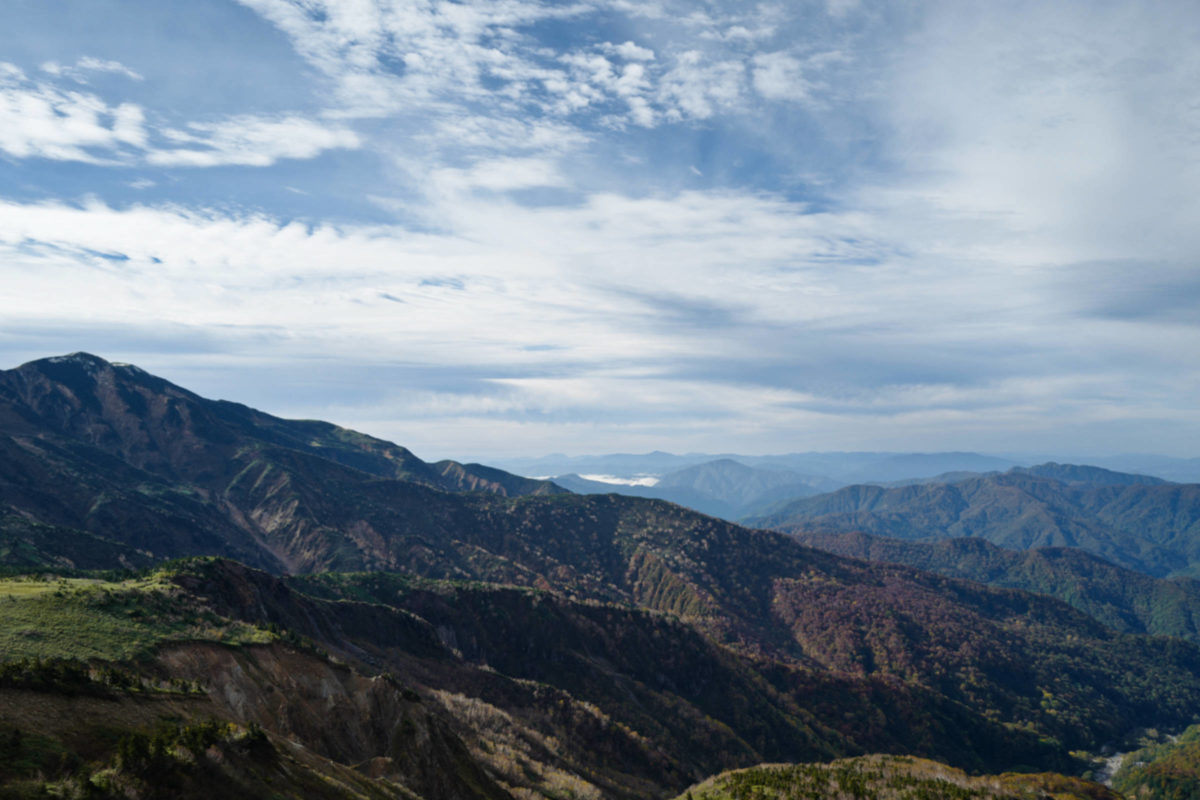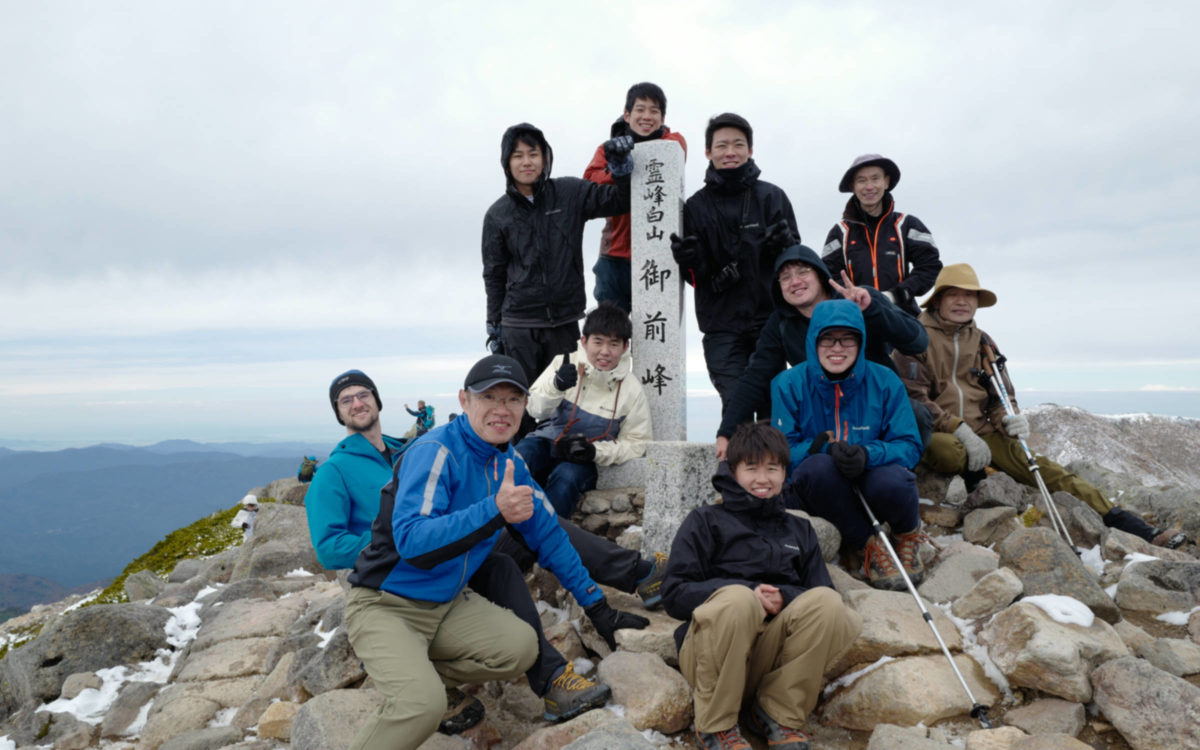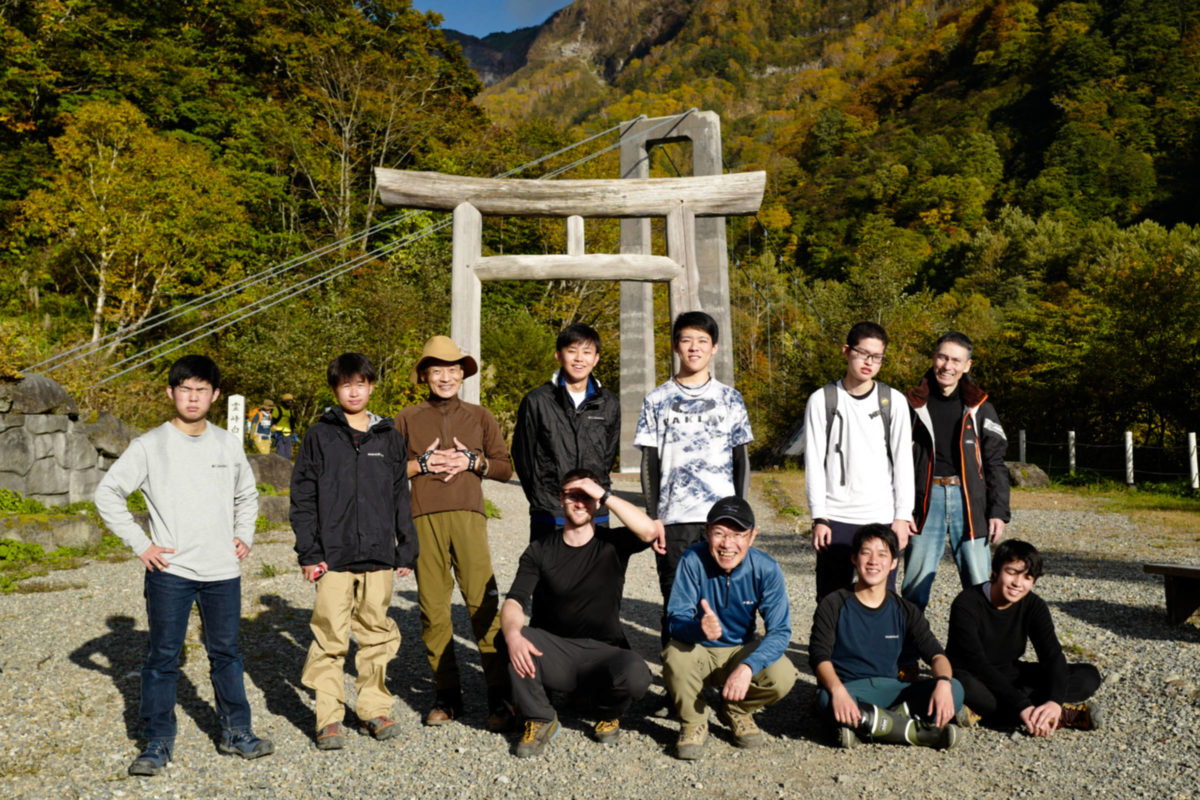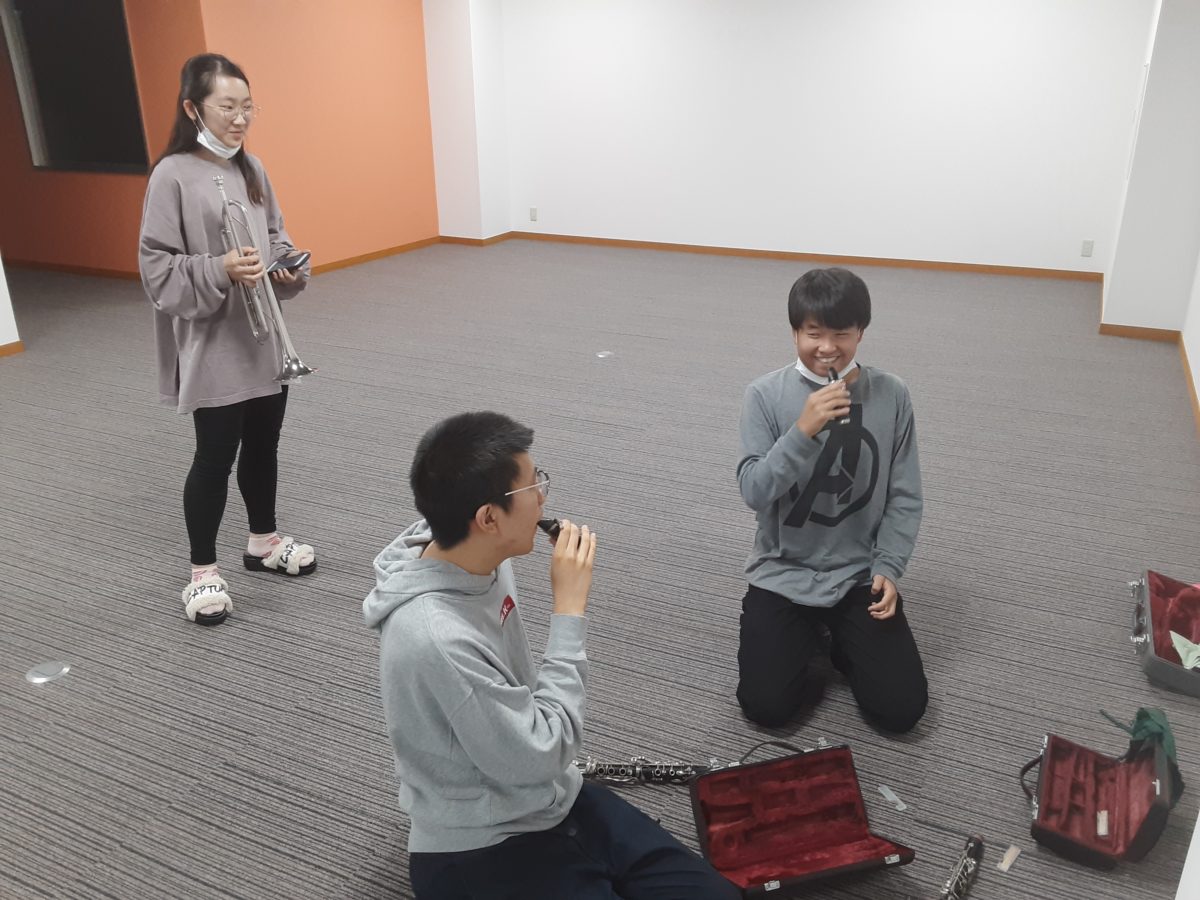FY 2020
2020年度の記事
 カメラマンのジョナサンです!今日は2年生の「エンジニアリングデザイン」の活動を紹介します。
カメラマンのジョナサンです!今日は2年生の「エンジニアリングデザイン」の活動を紹介します。
国際高専の問題発見解決型の授業、「エンジニアリングデザイン」では、学生がユーザーの視点に立って課題を明確化、解決策のアイデアを考慮しプロトタイプを作っています。今年は2年生7名が白山麓キャンパス校舎前の休耕田に着目して、「アグリテック班」「アグリビジネス班」の2つのグループに分かれて課題解決に挑みました。
昨年、課外活動の一環で、一部の学生と先生が白山麓キャンパス前にある休耕田でさつまいもを栽培しましたが、サルにより収穫のほとんどを奪われてしまいました。金沢工業大学と連携して、大学の研究室で試作された獣害対策ロボットを試しましたが、風などで動きのある自然を背景にした場合、動物の認識率が低いことがわかりました。そこで「アグリテック班」はAIを使って自然の中でもサルを認識できるシステムの開発を行うことにしました。後学期はプログラム開発を進め、11月に入ってからは津幡町にある石川県森林公園で、ニホンザルの写真を7,000枚撮ってシステムに学習させて認識の精度を高めました。これらの活動は11月13日(金)にNHK金沢放送局の「かがのとイブニング」にも取り上げられました。農作物の被害は全国的な課題となっており、今後は畑にサルが侵入した際に、所有者のスマートフォンに知らせるシステムの構築を目標にしています。
「アグリビジネス班」の学生たちは地域活性化を図るために「愛・AIいもプロジェクト」を4月に発足し、休耕田にさつまいも「紅はるか」の植え付け、草むしり、収穫を自ら行いました。今年は電気柵を使ってサル対策をしたおかげで栽培した芋の9割以上を収穫できました。学生たちは糖度計を使って収穫した紅はるかの糖度を計測したところ44度という非常に高い数値を確認し、焼き芋にするとねっとりと甘く、大変美味しいことがわかりました。学生たちは芋を洗ってから大きさごとに分別し、オリジナルデザインのラベルを貼って販売用にパッケージングを行いました。白山麓発のブランド化を目指して「甘熟紅はるか」と名付けられたこれらのさつまいもは道の駅「瀬女」や地元のスーパーで販売したところ、すぐに在庫がなくなるほどの人気でした。
次年度以降は、「アグリテック班」が開発した獣害対策システムの完成度向上を計りながらブランドのさつまいもの生産販売を地域と協力しながら推進する予定です。
ジョナサン
Hi, its Jonathan the cameraman. Today, I will give a report on what some of the second year students have been doing in "Engineering Design" class.
ICT's "Engineering Design" is a course in which students find problems in their community or society by interviewing people and creating prototypes that solve them. Seven of this year's second year students decided to focus on the unused fields across the street from the Hakusanroku Campus and start the "Ai Ai Imo Project", which consists of two groups: "Agri-tech" and "Agri-business".
Last year, some students planted sweet potatoes in the same field as part of their club activity. Despite their hard efforts, most of the potatoes were dug up and eaten by monkeys. They partnered with Kanazawa Institute of Technology to test a wild animal defense robot. However, it proved unable to detect animals when set in a wild environment due to wind moving the plants in the background. Learning this, the "Agri-tech" group decided to create a system that detects monkeys in the wild using AI. The actual construction of the system started this semester. In November, they traveled to the national park in Tsubata-machi and took over 7,000 pictures of the monkeys there to increase the accuracy of the AI. These activities were even featured on national television "Kaga-noto Evening" on November 13. Damage to crops by wild animals is a serious problem in Japan and the group hopes to develop a system that can detect monkeys entering a field and notify the owner via their smartphone.
The "Agri-business" group started the "Ai Ai Imo Project" in April. Their goal was to utilize the unused field to grow and sell sweet potatoes. To not repeat the same mistake as last year, this year's second year students built an electric fence around the patch to shut out the monkeys. Thanks to this and some quick decisions, they were able to harvest over 90% of the sweet potatoes. Students measured the sugar content of the potatoes, which turned out to be a remarkably high 44 degrees. After roasting and eating the sweet potatoes, we confirmed that they were rich, sweet and delicious. The students rinsed and separated the sweet potatoes by size, which they then packaged and labeled. These sweet potatoes were branded "Kanjuku (sweet and ripe) beni-haruka" and were sold at the michi-no-eki "Sena" souvenir shop and local super market "Yorankaine". They were extremely popular and sold out in a couple of days.
Next year, we hope to improve the system created by the "Agri-tech" group and work with the local community to further promote the sweet potatoes to draw people to Hakusanroku.
 カメラマンのジョナサンです!今日は2年生の「エンジニアリングデザイン」の活動を紹介します。
カメラマンのジョナサンです!今日は2年生の「エンジニアリングデザイン」の活動を紹介します。
国際高専の問題発見解決型の授業、「エンジニアリングデザイン」では、学生がユーザーの視点に立って課題を明確化、解決策のアイデアを考慮しプロトタイプを作っています。今年は2年生7名が白山麓キャンパス校舎前の休耕田に着目して、「アグリテック班」「アグリビジネス班」の2つのグループに分かれて課題解決に挑みました。
昨年、課外活動の一環で、一部の学生と先生が白山麓キャンパス前にある休耕田でさつまいもを栽培しましたが、サルにより収穫のほとんどを奪われてしまいました。金沢工業大学と連携して、大学の研究室で試作された獣害対策ロボットを試しましたが、風などで動きのある自然を背景にした場合、動物の認識率が低いことがわかりました。そこで「アグリテック班」はAIを使って自然の中でもサルを認識できるシステムの開発を行うことにしました。後学期はプログラム開発を進め、11月に入ってからは津幡町にある石川県森林公園で、ニホンザルの写真を7,000枚撮ってシステムに学習させて認識の精度を高めました。これらの活動は11月13日(金)にNHK金沢放送局の「かがのとイブニング」にも取り上げられました。農作物の被害は全国的な課題となっており、今後は畑にサルが侵入した際に、所有者のスマートフォンに知らせるシステムの構築を目標にしています。
「アグリビジネス班」の学生たちは地域活性化を図るために「愛・AIいもプロジェクト」を4月に発足し、休耕田にさつまいも「紅はるか」の植え付け、草むしり、収穫を自ら行いました。今年は電気柵を使ってサル対策をしたおかげで栽培した芋の9割以上を収穫できました。学生たちは糖度計を使って収穫した紅はるかの糖度を計測したところ44度という非常に高い数値を確認し、焼き芋にするとねっとりと甘く、大変美味しいことがわかりました。学生たちは芋を洗ってから大きさごとに分別し、オリジナルデザインのラベルを貼って販売用にパッケージングを行いました。白山麓発のブランド化を目指して「甘熟紅はるか」と名付けられたこれらのさつまいもは道の駅「瀬女」や地元のスーパーで販売したところ、すぐに在庫がなくなるほどの人気でした。
次年度以降は、「アグリテック班」が開発した獣害対策システムの完成度向上を計りながらブランドのさつまいもの生産販売を地域と協力しながら推進する予定です。
ジョナサン
Hi, its Jonathan the cameraman. Today, I will give a report on what some of the second year students have been doing in "Engineering Design" class.
ICT's "Engineering Design" is a course in which students find problems in their community or society by interviewing people and creating prototypes that solve them. Seven of this year's second year students decided to focus on the unused fields across the street from the Hakusanroku Campus and start the "Ai Ai Imo Project", which consists of two groups: "Agri-tech" and "Agri-business".
Last year, some students planted sweet potatoes in the same field as part of their club activity. Despite their hard efforts, most of the potatoes were dug up and eaten by monkeys. They partnered with Kanazawa Institute of Technology to test a wild animal defense robot. However, it proved unable to detect animals when set in a wild environment due to wind moving the plants in the background. Learning this, the "Agri-tech" group decided to create a system that detects monkeys in the wild using AI. The actual construction of the system started this semester. In November, they traveled to the national park in Tsubata-machi and took over 7,000 pictures of the monkeys there to increase the accuracy of the AI. These activities were even featured on national television "Kaga-noto Evening" on November 13. Damage to crops by wild animals is a serious problem in Japan and the group hopes to develop a system that can detect monkeys entering a field and notify the owner via their smartphone.
The "Agri-business" group started the "Ai Ai Imo Project" in April. Their goal was to utilize the unused field to grow and sell sweet potatoes. To not repeat the same mistake as last year, this year's second year students built an electric fence around the patch to shut out the monkeys. Thanks to this and some quick decisions, they were able to harvest over 90% of the sweet potatoes. Students measured the sugar content of the potatoes, which turned out to be a remarkably high 44 degrees. After roasting and eating the sweet potatoes, we confirmed that they were rich, sweet and delicious. The students rinsed and separated the sweet potatoes by size, which they then packaged and labeled. These sweet potatoes were branded "Kanjuku (sweet and ripe) beni-haruka" and were sold at the michi-no-eki "Sena" souvenir shop and local super market "Yorankaine". They were extremely popular and sold out in a couple of days.
Next year, we hope to improve the system created by the "Agri-tech" group and work with the local community to further promote the sweet potatoes to draw people to Hakusanroku.
 国の重要無形文化財に登録されている白山麓地域の伝統芸能の人形浄瑠璃「でくのまわし」をテーマとしたプロジェクトを思案している2年生のグループがある。彼らは、前期授業で地域調査をはじめ、この地域ならではの価値について考えた。後期授業では、導きだした価値を活かしたプロジェクトを考えている。
国の重要無形文化財に登録されている白山麓地域の伝統芸能の人形浄瑠璃「でくのまわし」をテーマとしたプロジェクトを思案している2年生のグループがある。彼らは、前期授業で地域調査をはじめ、この地域ならではの価値について考えた。後期授業では、導きだした価値を活かしたプロジェクトを考えている。
11月15日には、徳島の浄瑠璃団体の座長として活動されているマーティン・ホルマンさんによる人形浄瑠璃講演を白山市東二口歴史民俗資料館で聞くことができた(白山市国際交流協会主催)。ちなみに以前のジャーナルにも掲載されていたが、彼らの東二口への訪問は2回目となる。今回の目的は、浄瑠璃の理解をより深める事と、学生たちが思案しているプロジェクトについて、演じる方に意見を伺うことである。
講演はホルマンさんの人形浄瑠璃に関わるきっかけや、人形の操り方、人形浄瑠璃をどのように思っているかなど、いろんな角度からお話を聞くことができた。日本人でない方が日本の伝統芸能に情熱的に関わっている姿に、感慨深いものを感じた。講演後には、東二口の演目である大職冠の一部を鑑賞した。学生は徳島の人形を動かす機会もあり、地域の演技特徴を比べながら人形浄瑠璃について深く知る機会を得た。
企画後に学生達は、ホルマンさんや東二口の方々と交流を図っていた。今回の交流を通じて得た情報、感じた事は学生達の考え出したプロジェクト案に反映され、より充実した内容になることが期待できる。
小高有普
One group of second year students have started a project targeting the local "important intangible cultural property", traditional performing art here in Hakusanroku, the puppet theatre "Deku-mawashi". In the first semester, they gathered information from the local community and evaluated its unique importance. Currently in the second semester, they are working on a project to improve its situation.
On November 15, we were able to listen to a lecture by chairman of Ningyo-joruri (traditional puppet theatre) in Tokushima prefecture, Martin Holman at the folk museum in Higashi-futakuchi, Hakusan city (the event was organized by Hakusan International Asosiation). You may have read the previous journal entry and know that it is the students second time to visit here. Our goal this time was to deepen our knowledge of Ningyo-joruri and ask the performers for feedback on the students' proposal.
Listening to the lecture by Mr. Holman, we learned how he got involved with Ningyo-joruri, how to operate the puppets, and what his opinion is about the art. It was moving to listen to a foreigner speak so passionately about Japanese traditional art. After the lecture, we watched a part of the play "Taishokukan" and students were able to touch some of the puppets from Tokushima. It was informative and interesting to compare the differences between Ishikawa and Tokushima.
After the event, students continued to gather information from Mr. Holman and the Higashi-futakuchi members. The knowledge and feedback they gathered will improve their project even further.
Arihiro Kodaka
 国の重要無形文化財に登録されている白山麓地域の伝統芸能の人形浄瑠璃「でくのまわし」をテーマとしたプロジェクトを思案している2年生のグループがある。彼らは、前期授業で地域調査をはじめ、この地域ならではの価値について考えた。後期授業では、導きだした価値を活かしたプロジェクトを考えている。
国の重要無形文化財に登録されている白山麓地域の伝統芸能の人形浄瑠璃「でくのまわし」をテーマとしたプロジェクトを思案している2年生のグループがある。彼らは、前期授業で地域調査をはじめ、この地域ならではの価値について考えた。後期授業では、導きだした価値を活かしたプロジェクトを考えている。
11月15日には、徳島の浄瑠璃団体の座長として活動されているマーティン・ホルマンさんによる人形浄瑠璃講演を白山市東二口歴史民俗資料館で聞くことができた(白山市国際交流協会主催)。ちなみに以前のジャーナルにも掲載されていたが、彼らの東二口への訪問は2回目となる。今回の目的は、浄瑠璃の理解をより深める事と、学生たちが思案しているプロジェクトについて、演じる方に意見を伺うことである。
講演はホルマンさんの人形浄瑠璃に関わるきっかけや、人形の操り方、人形浄瑠璃をどのように思っているかなど、いろんな角度からお話を聞くことができた。日本人でない方が日本の伝統芸能に情熱的に関わっている姿に、感慨深いものを感じた。講演後には、東二口の演目である大職冠の一部を鑑賞した。学生は徳島の人形を動かす機会もあり、地域の演技特徴を比べながら人形浄瑠璃について深く知る機会を得た。
企画後に学生達は、ホルマンさんや東二口の方々と交流を図っていた。今回の交流を通じて得た情報、感じた事は学生達の考え出したプロジェクト案に反映され、より充実した内容になることが期待できる。
小高有普
One group of second year students have started a project targeting the local "important intangible cultural property", traditional performing art here in Hakusanroku, the puppet theatre "Deku-mawashi". In the first semester, they gathered information from the local community and evaluated its unique importance. Currently in the second semester, they are working on a project to improve its situation.
On November 15, we were able to listen to a lecture by chairman of Ningyo-joruri (traditional puppet theatre) in Tokushima prefecture, Martin Holman at the folk museum in Higashi-futakuchi, Hakusan city (the event was organized by Hakusan International Asosiation). You may have read the previous journal entry and know that it is the students second time to visit here. Our goal this time was to deepen our knowledge of Ningyo-joruri and ask the performers for feedback on the students' proposal.
Listening to the lecture by Mr. Holman, we learned how he got involved with Ningyo-joruri, how to operate the puppets, and what his opinion is about the art. It was moving to listen to a foreigner speak so passionately about Japanese traditional art. After the lecture, we watched a part of the play "Taishokukan" and students were able to touch some of the puppets from Tokushima. It was informative and interesting to compare the differences between Ishikawa and Tokushima.
After the event, students continued to gather information from Mr. Holman and the Higashi-futakuchi members. The knowledge and feedback they gathered will improve their project even further.
Arihiro Kodaka
 こんにちは、カメラマンのジョナサンです。2020年10月18日(日)、ネイチャー&アドベンチャークラブの白山登山に同行してきました。白山は石川県と岐阜県にまたがる標高2702mの活火山で、富士山と立山と並んで日本三霊山のひとつです。ネイチャー&アドベンチャークラブでは白山登山が恒例行事となっていますが、今年は9月の予定日が台風と重なってしまって18日が最後のチャンスだったのですが、ありがたいことに天候にも恵まれて実施ができました。私たちは早朝5時に玄関前に集合し、登山口の別当出合へ移動しました。前日17日に白山の初冠雪が報道されたためか、たくさんの登山客が来ていました。
こんにちは、カメラマンのジョナサンです。2020年10月18日(日)、ネイチャー&アドベンチャークラブの白山登山に同行してきました。白山は石川県と岐阜県にまたがる標高2702mの活火山で、富士山と立山と並んで日本三霊山のひとつです。ネイチャー&アドベンチャークラブでは白山登山が恒例行事となっていますが、今年は9月の予定日が台風と重なってしまって18日が最後のチャンスだったのですが、ありがたいことに天候にも恵まれて実施ができました。私たちは早朝5時に玄関前に集合し、登山口の別当出合へ移動しました。前日17日に白山の初冠雪が報道されたためか、たくさんの登山客が来ていました。
準備ののち、6時半に登山を開始しました。早朝の空気は冷えていましたが、中飯場に到着する頃には上着を脱ぐほどに温まっていました。甚之助避難小屋付近では紅葉が始まった山々のパノラマが見られるようになり、学生たちは双眼鏡やカメラを使って眼中に収めていました。参加した学生のほとんどが初の白山登山で、苦しい時間もありましたがペースを調節したり声を掛け合いながら奮闘しました。黒ボコ岩を越えた弥陀ヶ原からはスカッと晴れた空をバックに御前峰が見えました。室堂に近づくと雪の出現とともに本格的に冷えてきました。全員防寒具を装着して最後の登りに臨みました。
室堂の先は気温が一気に氷点下に下がりました。風も強くなり、体感気温は真冬の雪山のようでした。頂上に到着した私たちを待っていたのは雪化粧がされた御前峰と、能登半島まで見渡せる澄み切った空でした。登頂時刻は11時頃でした。寒さで体力の消耗が激しかったので滞在時間が限られていましたが、学生たちは景色を見たり、叫んでみたりして石川県のてっぺんを堪能しました。室堂に戻ってからは昼食をとり、下山しました。黒ボコ岩まで戻ると気温も上がり、涼しいと思えるようになりました。別当出合に到着したのは15時半頃で、最後の集合写真を撮りました。辛かった者、余裕だった者、楽しかった者、様々でしたが全員が日常生活を離れ、普段見れない景色、できない体験をした貴重な一日となりました。
ジョナサン
Hello! It's Jonathan, the camera man. On October 18, 2020, the Nature & Adventure Club held their annual Mt. Hakusan climb. Mt. Hakusan means "white mountain" in Japanese and is located across Ishikawa prefecture and Gifu prefecture. It is 2702m high and is one of Japan's three sacred mountains along with Mt. Fuji and Mt. Tateyama. The Nature & Adventure Club was scheduled to climb Hakusan in September but this was canceled because of a typhoon. October 18 was our last chance and we were rewarded for our patience with perfect skies. We gathered at front entrance of the Hakusanroku Campus at 5 am and drove to Betto-deai, the starting point on the Ishikawa prefecture side. It just snowed for the first time this year on the day before, and the parking lot was full of climbers, possibly prompted by the news.
We began our assent around 6:30 am. It was chilly at first but warmed up as the sun came up. The leaves were beautifully colored with many reds, oranges, and yellows. After Jinnosuke Cabin, the scenery opened up and we could see the panorama of mountains surrounding Hakusan. Students enjoyed this view, some with cameras and binoculars. For most of the students, this was their first time climbing Mt. Hakusan and the going was not always easy. However, students pushed on at their own pace. After Kuroboko-iwa, we could see the white peak across from Mida-ga-hara, with a blue sky background. The temperature began to decline as we approached Murodo. There, we geared up and made the final climb to the peak, Gozen-ga-mine.
The temperature dropped below 0 degrees celsius past Murodo and wind felt like a blizzard in mid winter. When we finally reached the top around 11 am, we were greeted by a freshly coated Gozen-ga-mine and blue skies so clear that you could see Noto peninsula in the distance. We enjoyed the awesome view as long as we could bear. Some students even began shouting for the fun of it. After returning to Murodo, we all ate lunch and began our decent. Temperatures finally rose again after Kugoboko-iwa and we could appreciate to cool breeze. We arrived at Betto-deai around 3:30 pm, concluding our trip with a group photo. The students' reactions to the experience differed. Some enjoyed it, some found it easier than they expected, and some vowed to never do it again. In any case, it was an unique opportunity to see new sites and try something new.
Jonathan
-
出発前 別当出合にて
-
中飯場の休憩所
-
学生のリュックにこっそり石を詰めるイタズラなフィリップ先生
-
登る様子
-
景色を堪能する学生
-
紅葉が始まった白山の山々
-
澄んだ空気と空
-
黒ボコ岩を目指して
-
フィリップ先生 黒ボコ岩にて
-
黒ボコ岩で黄昏る学生
-
集合写真 弥陀ヶ原にて
-
室堂で防寒具を装着
-
御前峰にて
-
御前峰にて
-
岩陰で風を凌いでいた中里さん
-
頂上から見る室堂
-
昨日初冠雪を迎えた白山
-
世界に向かって吠える
-
室堂に戻って昼食
-
昼食をとる学生
-
黒ボコ岩で主人公になる
-
下山し燃え尽きた学生
-
下山後の集合写真
 こんにちは、カメラマンのジョナサンです。2020年10月18日(日)、ネイチャー&アドベンチャークラブの白山登山に同行してきました。白山は石川県と岐阜県にまたがる標高2702mの活火山で、富士山と立山と並んで日本三霊山のひとつです。ネイチャー&アドベンチャークラブでは白山登山が恒例行事となっていますが、今年は9月の予定日が台風と重なってしまって18日が最後のチャンスだったのですが、ありがたいことに天候にも恵まれて実施ができました。私たちは早朝5時に玄関前に集合し、登山口の別当出合へ移動しました。前日17日に白山の初冠雪が報道されたためか、たくさんの登山客が来ていました。
こんにちは、カメラマンのジョナサンです。2020年10月18日(日)、ネイチャー&アドベンチャークラブの白山登山に同行してきました。白山は石川県と岐阜県にまたがる標高2702mの活火山で、富士山と立山と並んで日本三霊山のひとつです。ネイチャー&アドベンチャークラブでは白山登山が恒例行事となっていますが、今年は9月の予定日が台風と重なってしまって18日が最後のチャンスだったのですが、ありがたいことに天候にも恵まれて実施ができました。私たちは早朝5時に玄関前に集合し、登山口の別当出合へ移動しました。前日17日に白山の初冠雪が報道されたためか、たくさんの登山客が来ていました。
準備ののち、6時半に登山を開始しました。早朝の空気は冷えていましたが、中飯場に到着する頃には上着を脱ぐほどに温まっていました。甚之助避難小屋付近では紅葉が始まった山々のパノラマが見られるようになり、学生たちは双眼鏡やカメラを使って眼中に収めていました。参加した学生のほとんどが初の白山登山で、苦しい時間もありましたがペースを調節したり声を掛け合いながら奮闘しました。黒ボコ岩を越えた弥陀ヶ原からはスカッと晴れた空をバックに御前峰が見えました。室堂に近づくと雪の出現とともに本格的に冷えてきました。全員防寒具を装着して最後の登りに臨みました。
室堂の先は気温が一気に氷点下に下がりました。風も強くなり、体感気温は真冬の雪山のようでした。頂上に到着した私たちを待っていたのは雪化粧がされた御前峰と、能登半島まで見渡せる澄み切った空でした。登頂時刻は11時頃でした。寒さで体力の消耗が激しかったので滞在時間が限られていましたが、学生たちは景色を見たり、叫んでみたりして石川県のてっぺんを堪能しました。室堂に戻ってからは昼食をとり、下山しました。黒ボコ岩まで戻ると気温も上がり、涼しいと思えるようになりました。別当出合に到着したのは15時半頃で、最後の集合写真を撮りました。辛かった者、余裕だった者、楽しかった者、様々でしたが全員が日常生活を離れ、普段見れない景色、できない体験をした貴重な一日となりました。
ジョナサン
Hello! It's Jonathan, the camera man. On October 18, 2020, the Nature & Adventure Club held their annual Mt. Hakusan climb. Mt. Hakusan means "white mountain" in Japanese and is located across Ishikawa prefecture and Gifu prefecture. It is 2702m high and is one of Japan's three sacred mountains along with Mt. Fuji and Mt. Tateyama. The Nature & Adventure Club was scheduled to climb Hakusan in September but this was canceled because of a typhoon. October 18 was our last chance and we were rewarded for our patience with perfect skies. We gathered at front entrance of the Hakusanroku Campus at 5 am and drove to Betto-deai, the starting point on the Ishikawa prefecture side. It just snowed for the first time this year on the day before, and the parking lot was full of climbers, possibly prompted by the news.
We began our assent around 6:30 am. It was chilly at first but warmed up as the sun came up. The leaves were beautifully colored with many reds, oranges, and yellows. After Jinnosuke Cabin, the scenery opened up and we could see the panorama of mountains surrounding Hakusan. Students enjoyed this view, some with cameras and binoculars. For most of the students, this was their first time climbing Mt. Hakusan and the going was not always easy. However, students pushed on at their own pace. After Kuroboko-iwa, we could see the white peak across from Mida-ga-hara, with a blue sky background. The temperature began to decline as we approached Murodo. There, we geared up and made the final climb to the peak, Gozen-ga-mine.
The temperature dropped below 0 degrees celsius past Murodo and wind felt like a blizzard in mid winter. When we finally reached the top around 11 am, we were greeted by a freshly coated Gozen-ga-mine and blue skies so clear that you could see Noto peninsula in the distance. We enjoyed the awesome view as long as we could bear. Some students even began shouting for the fun of it. After returning to Murodo, we all ate lunch and began our decent. Temperatures finally rose again after Kugoboko-iwa and we could appreciate to cool breeze. We arrived at Betto-deai around 3:30 pm, concluding our trip with a group photo. The students' reactions to the experience differed. Some enjoyed it, some found it easier than they expected, and some vowed to never do it again. In any case, it was an unique opportunity to see new sites and try something new.
Jonathan
 国際高専は部活として三つクラブがあります。入学生はネイチャー&アドベンチャーかランゲージ&カルチャーかデザイン&ファブリケーションのクラブを選んで、いろんな活動をします。白山麓ジャーナルでみたことあると思います。今年からはもう一つのクラブができました。吹奏部というクラブです。
国際高専は部活として三つクラブがあります。入学生はネイチャー&アドベンチャーかランゲージ&カルチャーかデザイン&ファブリケーションのクラブを選んで、いろんな活動をします。白山麓ジャーナルでみたことあると思います。今年からはもう一つのクラブができました。吹奏部というクラブです。
吹奏部は国際理工学科2年生の井上武虎くんの発議で始まりました。井上くんは学校から許可をもらって、他の参加したい学生を見つけて、そして学生主事の瀧本先生のおがけで金沢キャンパスから楽器をもらいました。
7月初旬にやっと吹奏部の部員が初めて集まれました。井上くんは2年生の松浦祐大くんにクラリネットの組み立て方と吹き方を教えてあげました。大変そうだったけど、松浦くんは頑張りました!その間に、2年生の田中杏奈さんが一人でトロンペットを学び始めました。
吹奏部のメンバーだけが音楽能力を持っているわけではありません。ピアノ、ギター、ウクレレが出来る学生もいます。残念ながら僕は音楽能力が全くないので、音楽能力がある人と一緒にいるのはとても楽しいです。国際高専の学生たちはいろんな才能があるのは素晴らしいことです。国際高専ではSTEM教育はもちろん重要ですが、学生のクリエーティブ能力を育成することもとても大切だと思います。
ジェームス・テイラー(英語科)
Students at ICT are required to join a club when they enter the school: Design & Fabrication, Language & Culture, or Nature & Adventure. I’m sure you’ve read about those clubs’ activities in previous journal entries. This academic year, however, we have a new club: Music Club.
Music Club was started on the initiative of one of our second-year students, Taketora Inoue. He gained permission to start the club, found two other students who wanted to join, and we were able to procure some instruments from Kanazawa Campus thanks to the Dean of Students, Takimoto-sensei.
At the start of July, we were finally able to have our first Music Club get-together. Taketora taught Yuudai Matsuura how to put a clarinet together and how to blow into it. It looked like hard work! Meanwhile, Anna Tanaka began teaching herself the trumpet.
It’s not just the students in Music Club who have musical ability though. We have students who can play the piano, guitar, ukulele – and those are just the ones I’ve seen! As someone with no discernible musical talent, I’m always interested to watch people play instruments, and I think it’s great that we have students at ICT with different interests and talents. Of course, STEM education is very important here at ICT, but it’s also important to nurture our students’ artistic abilities too.
James Taylor (English Department)
 国際高専は部活として三つクラブがあります。入学生はネイチャー&アドベンチャーかランゲージ&カルチャーかデザイン&ファブリケーションのクラブを選んで、いろんな活動をします。白山麓ジャーナルでみたことあると思います。今年からはもう一つのクラブができました。吹奏部というクラブです。
国際高専は部活として三つクラブがあります。入学生はネイチャー&アドベンチャーかランゲージ&カルチャーかデザイン&ファブリケーションのクラブを選んで、いろんな活動をします。白山麓ジャーナルでみたことあると思います。今年からはもう一つのクラブができました。吹奏部というクラブです。
吹奏部は国際理工学科2年生の井上武虎くんの発議で始まりました。井上くんは学校から許可をもらって、他の参加したい学生を見つけて、そして学生主事の瀧本先生のおがけで金沢キャンパスから楽器をもらいました。
7月初旬にやっと吹奏部の部員が初めて集まれました。井上くんは2年生の松浦祐大くんにクラリネットの組み立て方と吹き方を教えてあげました。大変そうだったけど、松浦くんは頑張りました!その間に、2年生の田中杏奈さんが一人でトロンペットを学び始めました。
吹奏部のメンバーだけが音楽能力を持っているわけではありません。ピアノ、ギター、ウクレレが出来る学生もいます。残念ながら僕は音楽能力が全くないので、音楽能力がある人と一緒にいるのはとても楽しいです。国際高専の学生たちはいろんな才能があるのは素晴らしいことです。国際高専ではSTEM教育はもちろん重要ですが、学生のクリエーティブ能力を育成することもとても大切だと思います。
ジェームス・テイラー(英語科)
Students at ICT are required to join a club when they enter the school: Design & Fabrication, Language & Culture, or Nature & Adventure. I’m sure you’ve read about those clubs’ activities in previous journal entries. This academic year, however, we have a new club: Music Club.
Music Club was started on the initiative of one of our second-year students, Taketora Inoue. He gained permission to start the club, found two other students who wanted to join, and we were able to procure some instruments from Kanazawa Campus thanks to the Dean of Students, Takimoto-sensei.
At the start of July, we were finally able to have our first Music Club get-together. Taketora taught Yuudai Matsuura how to put a clarinet together and how to blow into it. It looked like hard work! Meanwhile, Anna Tanaka began teaching herself the trumpet.
It’s not just the students in Music Club who have musical ability though. We have students who can play the piano, guitar, ukulele – and those are just the ones I’ve seen! As someone with no discernible musical talent, I’m always interested to watch people play instruments, and I think it’s great that we have students at ICT with different interests and talents. Of course, STEM education is very important here at ICT, but it’s also important to nurture our students’ artistic abilities too.
James Taylor (English Department)
 秋来ぬと目にはさやかに見えねども風の音にぞおどろかれぬる
秋来ぬと目にはさやかに見えねども風の音にぞおどろかれぬる
(秋が来たと目にははっきりと見えないけれど、風の音で気づいたよ。)
古今和歌集 秋歌上 藤原敏行
こんにちは。国語科のKTBです。猛暑の夏がやっと終わり、朝晩には涼しい風を感じます。白山麓では秋風に乗って舞い降りてきたアサギマダラの、藤袴の蜜を求める華麗なワルツが今年も見られるようになりました。夏は白山の室堂辺りで涼んでいるのだそうです。


9月22日には公民館主催のマーキング調査会が開催され、ICTからは山崎俊太郎先生と事務局の渡邊晶子さん、そして私の3名が参加しました。昨年度までICTの学生寮のRAを勤めていらした山下和樹さんが公民館からお世話に来てくださいました。


解説はアサギマダラファンクラブ白山代表の中村明男さん。右奥が山下和樹さん。
マーキング調査とは、旅する蝶アサギマダラが、どのようなコースを、どれくらいの日数をかけて、どこまで飛んでいくのか、などを調べるために、捕まえて、羽にマーク(標識)を付けて放し、遥か海の向こうで再び誰かに捕まえてもらうというものです。去年はこの白山でマーキングした蝶が2頭(蝶は「頭」で数えます。珍しい昆虫なども飼育している西洋の動物園でのheadという数え方がその由来だそうですが。)、台湾まで飛んだそうですよ。
マーキングの方法は、虫取り網でまずはアサギマダラを捕らえます。手で触ると死んだふりをして動かなくなるので、羽に油性ペンで、白山(捕獲場所)・9.22(日付)・YK(私のイニシャル)・01(何番目に捕獲したものか)と記入します。私は9時から11時までで5頭の捕獲に成功しました。マーキングを終えると写真を撮ります。しばらくすると死んだふりをやめて、再び藤袴の蜜を求めて飛び立ちます。

死んだふりをして手を離しても動かないアサギマダラ(5頭目)。下羽に黒い斑点があるのは雄です。どこまで飛んでいくのかしら。がんばれよ。じゃあまたね。
潟辺豊
秋来ぬと目にはさやかに見えねども風の音にぞおどろかれぬる
You cannot tell to the eye that autumn has come, but I suddenly noticed it by the sound of the wind.
Kokin-waka-shu Fijiwara-no-Toshiyuki
Hello, it's your Japanese teacher, KTB. Finally the scorching summer has ended and I can feel the cool breeze in the morning and evening. At Hakusanroku, it's the season when the chestnut tiger butterflies arrive on the autumn wind and dance around the thoroughwort flowers. I hear they spend the hot season near Mt. Hakusan's pear.
The annual marking investigation event hosted by the community center was held on September 22 and Shuntaro Yamazaki sensei, Shoko Watanabe san from the office, and myself participated from ICT. We also met our former RA, Kazuki Yamashita san there.
Akio Nakamura san, Hakusan representative of the Chestnut Tiger Butterfly Fan Club gave an explanation. You can see Kazuki Yamashita san standing on the right.
Marking investigation is the measurement of how far a butterfly travels, what route it takes, and how many days it takes. You catch a butterfly and release it after marking its wings. Then, someone on the other side of the ocean will find it. Last year two butterflies marked here were found all the way in Taiwan.
To mark a chestnut tiger butterfly, first catch one with a net. They will play dead once you touch them so write "Hakusan" (place), 9.22 (date), YK (my initials), and 01 (number of butterfly you caught). I caught five butterflies between 9 and 11 am. After you are done, take a picture. Soon they will stop playing dead and fly away in search of more thoroughwort nectar.
The third picture is the fifth Chestnut Tiger butterfly I caught playing dead. Males have black patch on bottom wing. Don't know where you're going, but safe travels. Hope to see you again.
Yutaka Katabe
 秋来ぬと目にはさやかに見えねども風の音にぞおどろかれぬる
秋来ぬと目にはさやかに見えねども風の音にぞおどろかれぬる
(秋が来たと目にははっきりと見えないけれど、風の音で気づいたよ。)
古今和歌集 秋歌上 藤原敏行
こんにちは。国語科のKTBです。猛暑の夏がやっと終わり、朝晩には涼しい風を感じます。白山麓では秋風に乗って舞い降りてきたアサギマダラの、藤袴の蜜を求める華麗なワルツが今年も見られるようになりました。夏は白山の室堂辺りで涼んでいるのだそうです。


9月22日には公民館主催のマーキング調査会が開催され、ICTからは山崎俊太郎先生と事務局の渡邊晶子さん、そして私の3名が参加しました。昨年度までICTの学生寮のRAを勤めていらした山下和樹さんが公民館からお世話に来てくださいました。


解説はアサギマダラファンクラブ白山代表の中村明男さん。右奥が山下和樹さん。
マーキング調査とは、旅する蝶アサギマダラが、どのようなコースを、どれくらいの日数をかけて、どこまで飛んでいくのか、などを調べるために、捕まえて、羽にマーク(標識)を付けて放し、遥か海の向こうで再び誰かに捕まえてもらうというものです。去年はこの白山でマーキングした蝶が2頭(蝶は「頭」で数えます。珍しい昆虫なども飼育している西洋の動物園でのheadという数え方がその由来だそうですが。)、台湾まで飛んだそうですよ。
マーキングの方法は、虫取り網でまずはアサギマダラを捕らえます。手で触ると死んだふりをして動かなくなるので、羽に油性ペンで、白山(捕獲場所)・9.22(日付)・YK(私のイニシャル)・01(何番目に捕獲したものか)と記入します。私は9時から11時までで5頭の捕獲に成功しました。マーキングを終えると写真を撮ります。しばらくすると死んだふりをやめて、再び藤袴の蜜を求めて飛び立ちます。

死んだふりをして手を離しても動かないアサギマダラ(5頭目)。下羽に黒い斑点があるのは雄です。どこまで飛んでいくのかしら。がんばれよ。じゃあまたね。
潟辺豊
秋来ぬと目にはさやかに見えねども風の音にぞおどろかれぬる
You cannot tell to the eye that autumn has come, but I suddenly noticed it by the sound of the wind.
Kokin-waka-shu Fijiwara-no-Toshiyuki
Hello, it's your Japanese teacher, KTB. Finally the scorching summer has ended and I can feel the cool breeze in the morning and evening. At Hakusanroku, it's the season when the chestnut tiger butterflies arrive on the autumn wind and dance around the thoroughwort flowers. I hear they spend the hot season near Mt. Hakusan's pear.
The annual marking investigation event hosted by the community center was held on September 22 and Shuntaro Yamazaki sensei, Shoko Watanabe san from the office, and myself participated from ICT. We also met our former RA, Kazuki Yamashita san there.
Akio Nakamura san, Hakusan representative of the Chestnut Tiger Butterfly Fan Club gave an explanation. You can see Kazuki Yamashita san standing on the right.
Marking investigation is the measurement of how far a butterfly travels, what route it takes, and how many days it takes. You catch a butterfly and release it after marking its wings. Then, someone on the other side of the ocean will find it. Last year two butterflies marked here were found all the way in Taiwan.
To mark a chestnut tiger butterfly, first catch one with a net. They will play dead once you touch them so write "Hakusan" (place), 9.22 (date), YK (my initials), and 01 (number of butterfly you caught). I caught five butterflies between 9 and 11 am. After you are done, take a picture. Soon they will stop playing dead and fly away in search of more thoroughwort nectar.
The third picture is the fifth Chestnut Tiger butterfly I caught playing dead. Males have black patch on bottom wing. Don't know where you're going, but safe travels. Hope to see you again.
Yutaka Katabe











